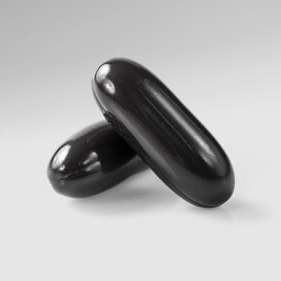BACKGROUND
Ingredient Type: Botanical, Extract
Also Known As: Tribulus terrestris, Bullhead, Calthrop, Caltrop, Cat’s-head, Common devil’s thorn, Devil’s eyelashes, Devil’s-weed, Goathead, Land caltrops, Mexican sandbur, Puncture plant, Puncture vine, Texas sandbur

Tribulus terrestris is a member of the Zygophyllaceae family. It is found in many warm regions around the world, and in some parts of North America has such extensive growth that it has become an invasive species. Due to the weed like and invasive nature of the plant, Tribulus has accumulated many nicknames such as; puncture vine, cow’s hoof, devil’s eyelashes, goat head, cat’s head, devil’s thorn, and bindii. These affectionate terms gain their meaning from the hard and spiked bur that is left behind about a week after the yellow flower has turned to fruit and easily crumbles to yield sharp thorny seed pods that frequently get stuck in you guessed it, cow’s hooves.
TRADITIONAL USES
Tribulus terrestris has been used historically in traditional Chinese medicine and Ayurveda as an aphrodisiac, cardiotonic, diuretic, and antimicrobial agent. In China, it is referred to as goat head and has been used for generations to tonify the kidneys, treat headache, vertigo and itchy skin caused by allergic reactions (1). Ayurvedic medicine utilizes extracts from the root and fruits for male virility, low libido and increasing overall vitality.
WHAT DOES SCIENCE TELL US?
Modern science has been able to isolate compounds of this plant and has found that the chemical constituents include flavonoids, alkaloids, lignin, amides, glycosides and most notably saponins (2). Steroidal saponins and flavonoids are the main contributing factors to the anti-inflammatory, antifungal, antibacterial and vasoactive pharmacological activity (3). Within the realm of herbal medicine, various types of saponins have been found to serve an ever-increasing amount of health benefits. Research on Tribulus terrestris has isolated at least 19 varieties of this chemical, meaning that the potential for use is hugely extensive (4).
Tribulus Possibly Helps Support Sexual Function:
The long history of use of Tribulus terrestris in libido and fertility treatments has sparked many studies inquiring the basis for this application. Literature shows that the ethanol extract of Tribulus may increase sperm production, therefore, improving men’s fertility (2). Increasing sperm count alone does not necessarily increase a man’s libido, yet there are important hormones associated with the effects of TT extract. The structure of protodioscin (PTN), the predominant saponin in T. Terrestris is very similar to that of DHEA, the precursor hormone to that of testosterone (5). DHEA is known to improve sexual function, mood, and fatigue in both men and women. While it has been shown that T. Terrestris does not directly increase testosterone levels in humans, the effect that the extract has on increasing the bioavailability of nitric oxide may be responsible for the cardiovascular and libido enhancing uses. By making blood vessels more responsive and allowing for increased blood flow, Tribulus terrestris is an ideal supplement in the treatment of erectile dysfunction.
Tribulus Possibly Supports Urinary Tract Health:
Scientific literature has followed up on the traditional Chinese application of Tribulus to enhance kidney function. Aqueous extracts of the fruit of T. terrestris contain quercetin, diosgenin, and tannic acid. These compounds are found to be preventative and curative in the most common types of kidney and urinary stones (3). Not only did it show potential to decrease the incidence of stone formation but is also found to be protective for the cells lining the kidney tubules and lead to reverse the abrasive injury from the stones. Clinical trials have found that water extracts of T. terrestris can decrease blood glucose after meals, and lead to a lower HbA1c (1). HbA1c is the average of blood glucose over the course of the last three months. This antidiabetic effect and thereby protecting the kidneys and small blood vessels from processing large glucose molecules can aid in diabetic symptomatology such as retinopathy, neuropathy, and increased frequency of urination.
Tribulus Possibly Helps Support Cardiovascular Health:
In addition to blood pressure lowering, there has been found to be blood lipid-lowering effects when patients are treated with aqueous and methanol extracts of Tribulus terrestris (5). By lowering the lipids and continually increased pressure inside blood vessels, T. terrestris can help prevent deposition of atherosclerotic plaque on the inner lining of arteries, thereby decreasing the risk of cardiovascular disease (3,6). Saponins in Tribulus terrestris are beneficial to the structure and function of cardiac muscle cells (3,6). After experiencing a heart attack, these components may aid in protection against a reperfusion injury that could help prevent further permanent damage to the heart muscle. Reperfusion injury is one of the more lethal effects a patient can experience post-heart attack.
Tribulus Possibly Has Antimicrobial Properties:
There has been much-specified research on the antimicrobial activity of Tribulus terrestris. By binding the outside of invading cells, the saponins in Tribulus terrestris is able to prevent binding to our own human cells and decrease risk of infection (7). The best results were found using methanol extract of the plant for many of the most commonly treated pathogens such as Candida albicans, E. coli, Staph aureus, and Pseudomonas aeruginosa (8). Adding Tribulus terrestris to a preventative regimen in those with frequent infections may be able to decrease future invasion and pharmaceutical antibiotic use
SAFETY
Safety in pregnancy and lactation has not been established and should therefore be avoided.
Side Effects:
Some animal studies have shown an increased sensitivity to sunlight upon ingestion of T. Terrestris, however, this has not yet been found in humans (9).
REFERENCES
- Zhang J-D, Xu Z, Cao Y-B, et al. Antifungal activities and action mechanisms of compounds from Tribulus terrestris L. Journal Of Ethnopharmacology. 2006;103(1):76-84.
- Oliveira NNPM, Félix MAR, Pereira TCS, Rocha LGP, Miranda JR, Zangeronimo MG et al. Sperm quality and testicular histomorphometry of wistar rats supplemented with extract and fractions of fruit of Tribulus terrestris L. Brazarch Biol Techn 2015;58(6):891–897.
- Wenyi Zhu, Yijie Du, Hong Meng, Yinmao Dong, Li Li. A review of traditional pharmacological uses, phytochemistry, and pharmacological activities of Tribulus terrestris. Chemistry Central Journal, Vol 11, Iss 1, Pp 1-16 (2017). 2017;(1):1. doi:10.1186/s13065-017-0289-x.
- Zhen-Fang Wang, Bing-Bing Wang, Yang Zhao, et al. Furostanol and Spirostanol Saponins from Tribulus terrestris. Molecules, Vol 21, Iss 4, p 429 (2016). 2016;(4):429. doi:10.3390/molecules21040429.
- Roaiah MF, El Khayat YI, Gamal El Din SF, Abd El Salam MA. Pilot Study on the Effect of Botanical Medicine (Tribulus terrestris) on Serum Testosterone Level and Erectile Function in Aging Males With Partial Androgen Deficiency (PADAM). Journal Of Sex & Marital Therapy. 2016;42(4):297-301. doi:10.1080/0092623X.2015.1033579.
- Jiang Y, Yang C, Li W, Wu S, Meng X, Li D. Aqueous extracts of Tribulus terrestris protects against oxidized low-density lipoprotein-induced endothelial dysfunction. Chinese Journal Of Integrative Medicine. 2016;22(3):193-200. doi:10.1007/s11655-015-2321-0.
- Aggarwal A, Tandon S, Singla SK, Tandon C. Diminution of oxalate induced renal tubular epithelial cell injury and inhibition of calcium oxalate crystallization in vitro by aqueous extract of Tribulus terrestris. International Braz J Urol: Official Journal Of The Brazilian Society Of Urology. 2010;36(4):480.
- Batoei Sara, Mahboubi Mohaddese, Yari Reza. Antibacterial activity of Tribulus terrestris methanol extract against clinical isolates of Escherichia coli. Herba Polonica, Vol 62, Iss 2, Pp 57-66 (2016). 2016;(2):57. doi:10.1515/hepo-2016-0011.
- McDonough SP, Woodbury AH, Galey FD, Wilson DW, East N, Bracken E. Hepatogenous photosensitization of sheep in California associated with ingestion of Tribulus terrestris (puncture vine). Journal Of Veterinary Diagnostic Investigation: Official Publication Of The American Association Of Veterinary Laboratory Diagnosticians, Inc. 1994;6(3):392-395.









